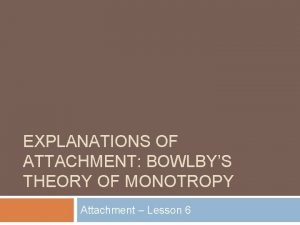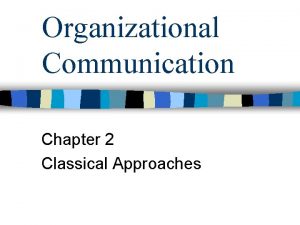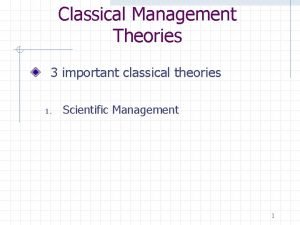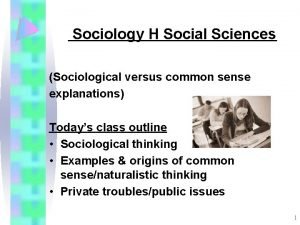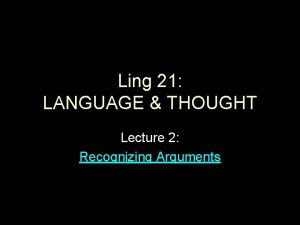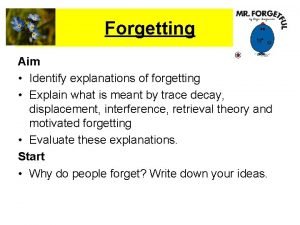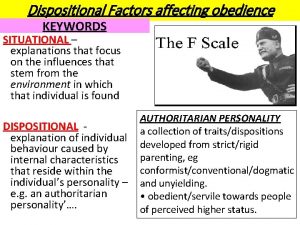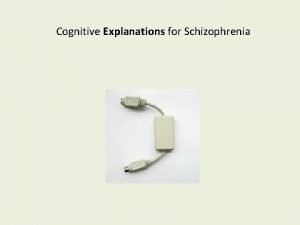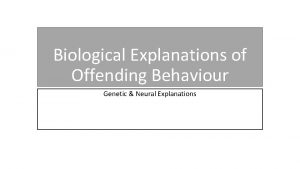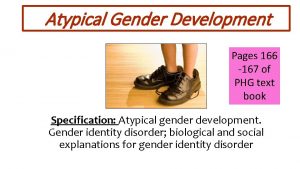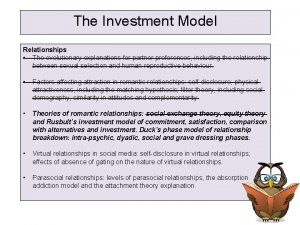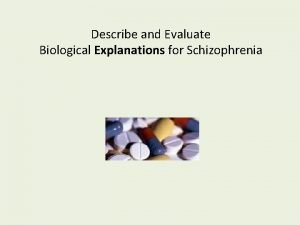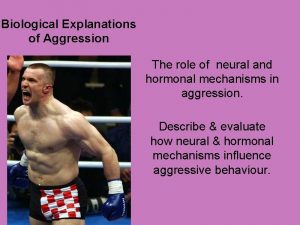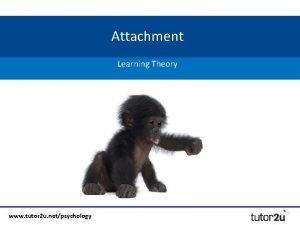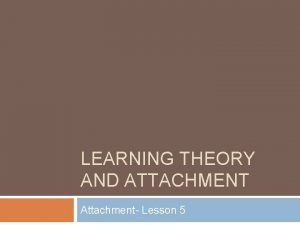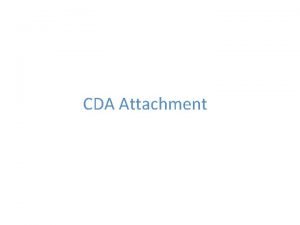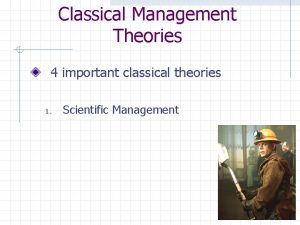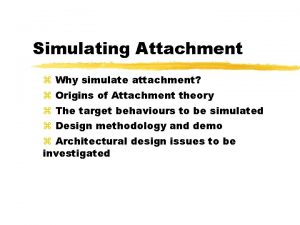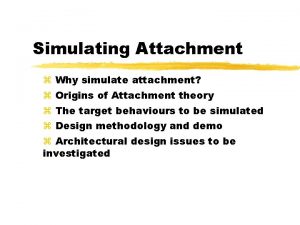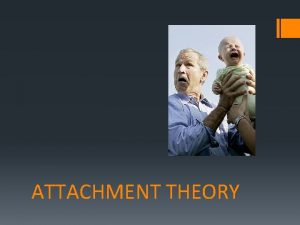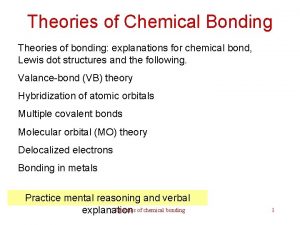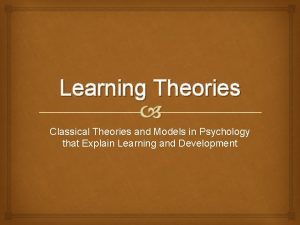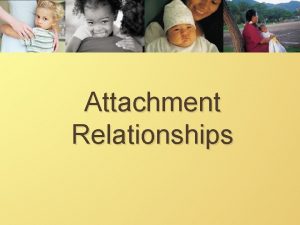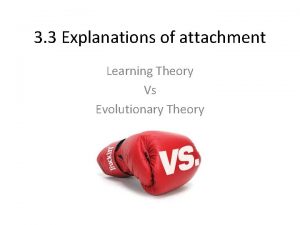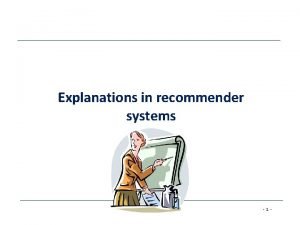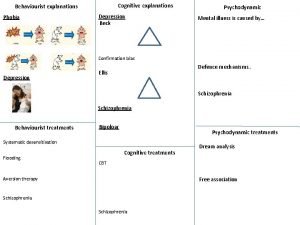Attachment Explanations of Attachment The Learning Theories Classical




















- Slides: 20

Attachment

Explanations of Attachment

The Learning Theories Classical conditioning • Learn by association • Strengthening the stimulus response bond • Pavlov and his dogs Unconditioned Stimulus Unconditioned Response Food Salivation Unconditioned Stimulus + Conditioned Stimulus Unconditioned Response Food + Bell Salivation Conditioned Stimulus Conditioned Response Bell Salivation • Therefore attachment is an association with the environment(stimuli) and the response • e. g. a baby will become attached to the mother because it associated food with her(reward), then the baby begins to associate other things with the mother such as love.

The Learning Theories Operant conditioning • Learn by positive/ negative reinforcement • As a response of behaviour • Skinner • pieces of cheese are placed at one point in the maze • the mouse moves around the maze and finds a piece of cheese(reward) • the mouse repeatedly goes to this spot and finds a piece of cheese(reward) • The mouse learns to follow a direct route because of this positive reinforcement • F: rewarding small acts can condition behaviour • C: in terms of attachment, attachments are formed through reinforcement of good behaviour e. g. A child is rewarded with milk when s/he finds the mothers breast, and is then conditioned to attach to the breast to find what it wants

The Learning Theories Social Learning Theory • learn by observation and mimicry • Phobias can be learned from observation alone • Mineka • Monkey babies observed their mothers being afraid of snakes, and they then develop a fear of snakes themselves • Emphasises the effect of models in behaviour • Hay and Vespo • A parent showing loving behaviour to a child, will be reciprocated with the child’s mimicry of loving behaviour therefore reinforcing attachment(parentchild bond)

The Learning Theories Critique ü Clearly explains attachment behaviour, so is easy to refer to and make conclusions about attachment ü Has practical implications, in improving parent-child bonds and attachment type as well as behaviour Ignores the act of biology/evolution in theories of attachment therefore is reductionist and cannot be fully relied upon to explain attachment SLT – Not all children learn by mimicry and observation, so from this perspective it doesn’t take account of individual differences therefore lacks transferability and reliability Evidence for operant conditioning by Skinner, was done in a laboratory, therefore has little mundane realism, and ecological validity, decreasing its application in the real world Evidence for operant conditioning by Skinner involved animals so issues of extrapolation present. The results concluded from this experiment cannot be successfully extended to humans, as there are large physiological and psychological differences between humans and mice.

Evolutionist Perspective Darwin and Imprinting • Darwin’s theory of evolution explains how attachment behaviour is an adaptive trait in humans • there is variation within a species • Variation is passed on through inheritance • More offspring are produced than survive • Selection pressure select those with the best adaptations • Those with the best adaptations survive and reproduce • Imprinting is the tendency to form a rapid attachment toward the 1 st large moving object and is an adaptive behaviour • Lorenze • Took ½ of the geese eggs from the mother and place them in an incubator : other ½ remained with the mother • When they hatched, Lorenze was the first large moving object they saw • Formed a rapid attachment • When placed back with other geese, they rapidly separated trying to find their primary caregiver • Klaus and Kennel • Increased contact leads to better attachment • 2 groups- control and extra contact. F: the extra contact showed better attachment

Evolutionist Perspective Bowlby • Attachment is an innate and adaptive process promoting survival: • providing a secure base of exploration • social releases • Internal working model – bases of all emotional relationships • Emotional deprivation can disrupt the attachment process = loss of emotional care leads the breaking of emotional bonds • Maternal deprivation hypothesis • If a child cannot develop an emotionally stable relationship with its primary caregiver within the first 2 ½ yrs(critical period) then it will have trouble forming successful relationships later on in life(internal working model) and become emotionally disturbed • 44 thieves • 88 kids(44 thieves and 44 controls) • F: most of the 44 thieves had prolonged separation from their mothers within the first 2 yrs of their lives

Evolutionist Perspective Critique ü Bowlby’s theory is supported by evidence increasing its reliability as an explanation of attachment(44 theives) ü The first comprehensive and systematic theory of attachment, which has been used partially by other theorists such as Freud therefore is mush have some credibility as a theory Data for bowlby’s theory was collected retrospectively, therefore is subject to social desirability bias so lacks reliability and as it relies on peoples memory it has decreased accuracy, therefore more evidence is needed to justify this theory The findings from bowlby’s study is correlation and cause and effect cannot be inferred therefore this perspective lacks justifiability, and more evidence is needed to establish if it is a cause or an effect This study is reductionist as it ignores psychological explanations such as the learning theory which may offer a more valid and up to date account of attachment, therefore it cannot be fully relied upon as a explanation of attachment and possibly a combination of the psychological and evolutionary explanations is needed. Bowlby’s theory mentions the need for a primary attachment figure which he mentions is the mother, however it doesn’t take account for single parent families in which the dad is the primary attachment figure, or that a child is likely to have more than one attachment figure, therefore this theory lacks mundane realism as it isn’t representative of the real world today

Evolutionist Perspective Freud - Psychodynamic • Supports the fact that attachment is innate and determines personality development • Personality is separated into three parts: • ID • EGO • SUPER EGO • The parts in personality influence how a child moves through the psychosexual stages: • Oral • Anal • Phallic • Latent • Genital

Types of Attachment, Including insecure, and secure attachment and studies by Ainsworth

Secure and Insecure Attachment • Explanations of insecure attachment(individual differences in attachment) • Maternal sensitivity • Ainsworth – attachment is determinate upon the sensitiveness of the mother to the child’s needs • Avoidant – caregivers were either uninterested, or over interested • Resistant – caregivers were interested in the infants but misunderstood their behaviour • Secure – caregivers were very sensitive to their needs • De Wolfe F: meta-analysis of studies finding +ve correlation to sensitivity and attachment type • Most evidence is correlational therefore it doesn’t prove that differences in maternal sensitivity cause differences in attachment • However if it did then by increasing maternal sensitivity, attachment type should also improve this is supported by Juffer • exaggerates the role of the mother and ignores paternal sensitivity which De Wolfe found to be moderately associated with attachment type • Ignores the role played be the infant as child’s attachment is innate

Secure and Insecure Attachment • Child’s Innate Temperament • Kagan – a child’s innate temperament is responsible for the quality of attachment between it and the caregiver • Belsky F: if the innate personality of a child showed behavioural instability then a child was less likely to be securely attached • O’Conner F: genetic factors influence attachment type slightly with regards to a study on M/Z + D/Z twins • However evidence has shown that there is no link to genetics and temperment in a study on M/Z + D/Z twins decreasing the reliability of temperament being genetic and innate • A child’s attachment type may vary maternally and paternally, suggesting that it is the parental characteristics that determine attachment type(De Wolfe) • Maltreatment • Baer and Martinez F: meta-analysis of studies investigating maltreatment and attachment type. Insecure attachment was more common among maltreated children

Secure and Insecure Attachment Do secure attachments last? ? • If attachment type is consistent over time then it is possible to assume that it is important in development • Wartner et al F: Most children’s attachments type remained the same from 12 months to 6 years • Factors within the family may alter attachment type • Weinfield et al F: changes in child maltreatment, family functioning were linked to discontinuous attachment type • On the basis of the internal working model, if a mother is brought up with a secure attachment then she is more likely to have a securely attached child, and if there is a change in the mothers/child’s life this often changes the attachment type (Thompson) How valuable is secure attachment? ? • Securely attached children have fewer behaviour and emotional problems • Securely attached children are more accepted into their peer group • Belsky • Secure – social competence and fewer behavioural problems : insecure • Most of this evidence is correlational as there association between attachment and measures so we cannot infer that attachment type causes these vice versa. • As you cannot randomly allocate a child to secure/insecure attachment groups we cannot be sure that these factors were caused by secure attachment

Secure and Insecure Attachment • The importance of secure attachment can be seen in animals studies by removing it. • Harlow and Harlow • Raised monkeys in total isolation – when placed with other monkeys, they were withdrawn and fearful • Raised monkeys with a wire monkey or a cloth monkey – monkeys formed an attachment to the cloth monkey and were more social • Groups of monkey’s raised together with no cloth/wire monkey – withdrawn, then developed characteristics of secure attachment suggesting that infant-infant bonds can be just as effective as parent-child bonds • Unethical today due to animal rights defending emotional damage done to the animal • Extrapolation, you cannot give conclusions for humans based upon this study with animals as there are differences decreasing its reliability • Gives us an account of the importance of secure attachment in emotional development when we ourselves cannot test this on humans due to ethics

Secure and Insecure Attachment • We cannot investigate attachment in the way we do with animals but we can only assess the quality of attachment an infer conclusions from it • Ainsworth’s “Strange Situation” is used to assess the quality of an infants attachment type • Takes 20 mins, and used American infants aged 12 -18 months • In a laboratory, observation Stage People in the room Procedure 1 M, I, R R bring M+I in room, leaves 2 M+I M sits, I explores 3 S, M+I S talks to M then I, M leaves 4 S+I S tries to interact with I 5 M +I, S S leaves as M returns. M leaves 6 I I alone 7 S+I S tries to interact with I 8 M+I S leaves as M returns

Secure and Insecure Attachment • Findings • Avoidant 20% (Type C) - unresponsive and avoidant • Resistant 10% (Type A) - distressed when M leaves, resistant on return • Secure 70% - (Type B) distressed when M leave, content on return, difference in reaction with M + S. • The insecure attachment types identified are reductionist as there may be more than three. A fourth attachment type, disorganised(Type D) – the Infant showed no consistent pattern of behaviour and didn’t fit the three above attachment types • Culturally bias to only American infants therefore results cannot be generalised to other cultures or countries • Lacks ecological validity and mundane realism due to the artificiality of the laboratory experiment, therefore its lacks transferability to the real world any results drawn from the experiment lack reliability in the real world • There is oversimplification of the categories as 2 infants may be classed as avoidant but one may display high avoidance and the other low avoidance, therefore for the results to be more experimentally reliable and accurate dimensions may need to be used so to take account of individual differences

Cultural Variations in Attachment

Cultural Variations in Attachment • If attachment is an innate behaviour we would expect it to be universal, to test this the strange situation is used, if it is innate then we would expect the results to be 20%(C) 10%(A) 70%(B) • Ijzendoon and Kroonenburg did the most influential research in cultural variations in attachment • Meta-analysis of studies on attachment using the strange situation, to test the external validity of the measure • 32 studies, none older than 24 months, 8 countries(5 western, 3 non-western), looked at attachment and the relationship maternally • Findings • secure attachment was most common in all countries • differences in the distribution of insecure attachments • Western – avoidant, Non western – resistant • variation of attachment type was greater within cultures than between them • Conclusions • the universal consistency of secure attachment suggests innate characteristics between caregiver and infant • there are significant differences in insecure attachment which partially reflect the cultural differences in child rearing • The large differences sub-culturally in attachment type mean that comparing attachment by culture would be an oversimplification and research would be best served comparing attachment in sub-cultures

Cultural Variations in Attachment • Critisms ü They were the first researchers to do a cross cultural meta-analysis of studies on the strange situation therefore there results were influential to attachment ü This research identifies the oversimplification of the fact that their is only one unified culture The study shows us the differences in attachment type across cultures but doesn’t explain why, we can only speculate as to why, therefore this study lacks experimental validity and justification It was found that there was much variation sub-culturally so comparing cultures as a whole may disregard/overlook differences giving a false account of cultural attachment The strange situation was produced in the US, therefore is subject to an imposed etic(based upon beliefs and attitudes of that culture therefore the results may not be fully representative of the culture being studied) The research is limited to only looking at attachment type up to 24 months therefore the research is age bias, and may lack reliability as attachment types are subject to change after 24 months(Wienfield) The results in themselves may be unreliable and inaccurate, as the studies used in the meta-analysis could be subject to bias, unreliability and inaccuracy in themselves
 Monotropy meaning bowlby
Monotropy meaning bowlby Classical model of communication
Classical model of communication Strategic trade theory
Strategic trade theory Management theory timeline
Management theory timeline Classical management era
Classical management era Common sense and sociological explanations
Common sense and sociological explanations Premise indicators
Premise indicators Motivational forgetting
Motivational forgetting Dispositional vs situational
Dispositional vs situational Cognitive explanations of schizophrenia
Cognitive explanations of schizophrenia New deal political cartoons and explanations
New deal political cartoons and explanations Russian revolution cartoons
Russian revolution cartoons Epq spec
Epq spec Neural explanations of offending behaviour
Neural explanations of offending behaviour Gender dysphoria biological explanations
Gender dysphoria biological explanations Rusbult's investment model
Rusbult's investment model Biological explanations of schizophrenia
Biological explanations of schizophrenia Biological explanations of aggression
Biological explanations of aggression Cuadro comparativo e-learning b-learning m-learning
Cuadro comparativo e-learning b-learning m-learning Tutor 2 u psychology
Tutor 2 u psychology Learning theory of attachment
Learning theory of attachment
